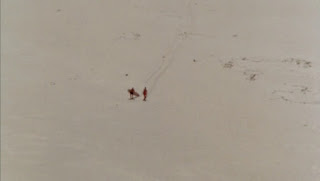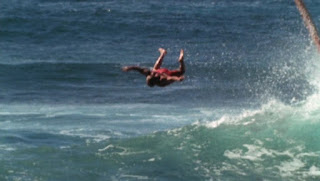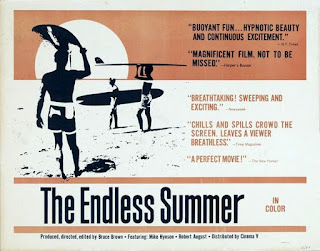“Many surfers ride summer and winter but the ultimate thing for most of us would be to have an endless summer; the warm water and waves without the summer crowds of California. The only way to do this is to travel around the world, following the summer season as it moves around the world…”
___ ___ ___ ___ ___ ___ ___ ___ ___ ___ ___ ___ ___ ___ ___ ___
Bruce Brown got his first surfboard in 1952. Well, it was more of a raft that the novice surfer cut and re-shaped into a 75-pound plank that more or less resembled a surfboard when he finished the last layer of fiber-glass coating. Of course, it was with a camera where Brown would make his true impact on surf-culture, first with still-photography, which he used to try and capture “the draw” of the sport, something almost spiritual on an elemental level.
Again, Brown hadn’t quite found his true medium yet but that soon changed during a hitch in the navy; for, while stationed in Oahu, Hawaii, Brown started shooting 8mm footage of his friends and fellow surfers doing their thing in many hot-spots around the islands. Then, after his discharge and a return home to California, Brown spliced all that film together into a rough, hour-long feature that he would barnstorm around Orange County, showing it in libraries and high school gyms, with him on stage controlling the volume on a tape recorder as he provided live narration of what was on screen while his wife, Pat, handled projector duties.
At some point the film caught the attention of Dale “Hawk” Velzy, a local surf legend and surfboard maker, who is also credited with opening the first ever commercial surfboard shop, and struck a deal to set-up a screening room in one of his outlets in San Clemente, charging admission, eventually raising enough money for an upgrade, allowing Brown to purchase a 16mm camera; and together, Velzy and Brown managed to raise nearly $5,000 for a “real” documentary feature on surfing, Slippery When Wet (1958), followed by Surf Crazy (1959), Barefoot Adventure (1960), and Surfing Hollow Days (1961); basically one film a year, shot during the summer and fall, then edited together over the winter, and then released ad hoc in the spring.
And each film used the exact same formula; spectacular footage shot by Brown (-- from the beach or on a board himself), with his dry and wry observations, and his drool and often misfiring sense of humor, usually coming straight off the cob, serving as the (very) informal narrative to tie it altogether. Mix all that with a mellow interstitial soundtrack and you essentially wound up with a Thorazine-drip of a mellowing, mesmerizing moving-picture that just draws you right out of your seat and into the water to paddle out with the subject matter.
"I never had formal training in filmmaking and that probably worked to my advantage,” said Brown. And it’s true. Everything he does shouldn’t work, and yet it totally does. As I said, each film thus far had taken a year to complete, but now, Brown was thinking about tackling something bigger, perhaps something that could be shown on a national scale, saying, "I felt if I could take two years to make a film, maybe I could make something really special." To fit that bill, he had a notion about a film which would feature a couple of surfers exploring areas that had never been surfed before on a solitary quest to find the perfect wave in the wilds of Africa. But then further inspiration hit when a travel agent informed Brown it was almost just as cheap to circumnavigate the whole globe as it was for a round-trip ticket to Capetown, South Africa, which planted the seed of not only finding that perfect wave but following the summer season around the world and experience a true endless summer.
To raise money for this endeavor, Brown mortgaged out his house and spliced all the best parts of his previous efforts into a new film, Waterlogged (1962), and took it out on tour to drum up support. And once he had enough scratch (-- approximately $50,000), Brown took off with two of his surfer buddies, Mike Hynson and Robert August, and a minimal crew of two (Rodney Sumpter and Nat Young), finding and hitting all kinds of spots up and down the African coast (-- and finding that perfect wave along the way on the Cape of St. Francis), experiencing some massive culture shock, too, but more or less spreading good will as they went, then to Australia (-- which turned into a major bummer), then New Zealand, and Tahiti, and eventually ending up in Hawaii.
The surf-footage Brown captured along the way is truly amazing, spliced into some ersatz travelogue footage and some massive inserts from earlier shoots. (The scenes of the mammoth surf at Waimea Bay and the Herculean efforts to conquer it could stand as its own mini-feature.) And as he edited it all together the filmmaker struck gold by striking a deal with The Sandals, who provided the mellowest theme of ever and several other tunes for the soundtrack, mixed in liberally with several library stock cues to great effect.
When the film was completed in 1964, Brown shopped The Endless Summer around to several studios but found nary a nibble. Seems they felt it had no mainstream appeal and would never play anywhere that wasn’t 10 feet from the ocean. Undaunted, Brown booked a two-week run in Wichita, Kansas, in the dead of winter, which quickly sold out as the frozen land-locked denizens soaked up all that fun in the eternal sun. But it wasn’t until after Brown took the film to New York City, where it played successfully for nearly a year, that the quarter finally dropped for several distributors, with Cinema V winning out because they were satisfied with releasing the film as is (-- the only change this distributor made was to blow up the 16mm print to 35mm before releasing it), while the others had demanded several changes, including junking John Van Hamersveld’s iconic poster art, lighting a fire that turned a local craze into a national phenomenon, earning the film nearly $5-million domestically and over $20-million internationally.
With the nigh inexplicable success of his little documentary that could, with his laconic, laid-back narration, where he makes the right decision to be an enthusiastic presenter and not a zealous preacher of the culture he loves, and a simplistic and minimalist style that is best described as just ‘point and shoot’, Brown was soon dubbed the “Bergman of the boards,” by TIME magazine and anointed the “Fellini of the foam” by The New York Times. Famed film critic Roger Ebert was equally flummoxed by the mass appeal of the film, himself afflicted, pondering and observing over how “Brown used only what he could carry, shunning the tons of equipment ordinarily taken along on location. The beautiful photography he brought home almost makes you wonder if Hollywood hasn't been trying too hard."
Personally, I am a huge fan of this film and The Endless Summer has held a spot in my top ten going on three decades now since I first saw it on one of the Superstations many moon-doogies ago. And I know this film is personally responsible for the galloping delusion that I harbor the soul of a surfer, currently trapped in a large gelatinous mass that couldn’t be any further from either ocean if he tried. (And it's also why this song will most probably be played at my funeral.) Ah, well, I would make a better buoyant surfboard than a surfer but live to live vicariously and all of that.
2016 marks the 50th Anniversary of The Endless Summer’s national release in 1966 and it still holds its power to put the hypno-whammy on an audience to this very day. And I think it’s that very same simplicity and amateur gung-ho approach that has allowed it to age so gracefully when most other relics of the 1960s surf-boom come off as pure camp. No, this errant quest of two “hotdogging Galahads out searching for the perfect wave” is a lot deeper than that. How deep? Well, that’s up to each individual viewer. And if you haven’t had the pleasure of watching it yet, I encourage you to come on in, the water’s fine and the conditions don’t get much more perfect than this film right here.
Other Points of Interest:
The Endless Summer (1966) Bruce Brown Films :: Monterey Media / P: Robert Bagley, Bruce Brown / D: Bruce Brown / W: Bruce Brown / C: Bruce Brown / E: Bruce Brown / M: The Sandals / S: Robert August, Michael Hynson, Terence Bullen, Bruce Brown



















































No comments:
Post a Comment